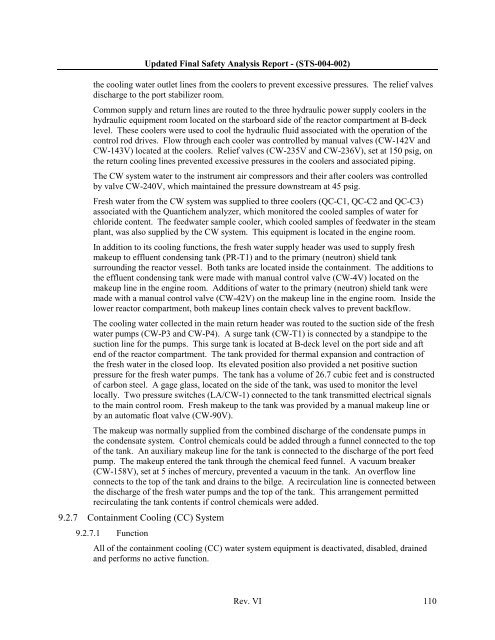10 CFR 50.71(e) - Maritime Administration - U.S. Department of ...
10 CFR 50.71(e) - Maritime Administration - U.S. Department of ...
10 CFR 50.71(e) - Maritime Administration - U.S. Department of ...
Create successful ePaper yourself
Turn your PDF publications into a flip-book with our unique Google optimized e-Paper software.
Updated Final Safety Analysis Report - (STS-004-002)the cooling water outlet lines from the coolers to prevent excessive pressures. The relief valvesdischarge to the port stabilizer room.Common supply and return lines are routed to the three hydraulic power supply coolers in thehydraulic equipment room located on the starboard side <strong>of</strong> the reactor compartment at B-decklevel. These coolers were used to cool the hydraulic fluid associated with the operation <strong>of</strong> thecontrol rod drives. Flow through each cooler was controlled by manual valves (CW-142V andCW-143V) located at the coolers. Relief valves (CW-235V and CW-236V), set at 150 psig, onthe return cooling lines prevented excessive pressures in the coolers and associated piping.The CW system water to the instrument air compressors and their after coolers was controlledby valve CW-240V, which maintained the pressure downstream at 45 psig.Fresh water from the CW system was supplied to three coolers (QC-C1, QC-C2 and QC-C3)associated with the Quantichem analyzer, which monitored the cooled samples <strong>of</strong> water forchloride content. The feedwater sample cooler, which cooled samples <strong>of</strong> feedwater in the steamplant, was also supplied by the CW system. This equipment is located in the engine room.In addition to its cooling functions, the fresh water supply header was used to supply freshmakeup to effluent condensing tank (PR-T1) and to the primary (neutron) shield tanksurrounding the reactor vessel. Both tanks are located inside the containment. The additions tothe effluent condensing tank were made with manual control valve (CW-4V) located on themakeup line in the engine room. Additions <strong>of</strong> water to the primary (neutron) shield tank weremade with a manual control valve (CW-42V) on the makeup line in the engine room. Inside thelower reactor compartment, both makeup lines contain check valves to prevent backflow.The cooling water collected in the main return header was routed to the suction side <strong>of</strong> the freshwater pumps (CW-P3 and CW-P4). A surge tank (CW-T1) is connected by a standpipe to thesuction line for the pumps. This surge tank is located at B-deck level on the port side and aftend <strong>of</strong> the reactor compartment. The tank provided for thermal expansion and contraction <strong>of</strong>the fresh water in the closed loop. Its elevated position also provided a net positive suctionpressure for the fresh water pumps. The tank has a volume <strong>of</strong> 26.7 cubic feet and is constructed<strong>of</strong> carbon steel. A gage glass, located on the side <strong>of</strong> the tank, was used to monitor the levellocally. Two pressure switches (LA/CW-1) connected to the tank transmitted electrical signalsto the main control room. Fresh makeup to the tank was provided by a manual makeup line orby an automatic float valve (CW-90V).The makeup was normally supplied from the combined discharge <strong>of</strong> the condensate pumps inthe condensate system. Control chemicals could be added through a funnel connected to the top<strong>of</strong> the tank. An auxiliary makeup line for the tank is connected to the discharge <strong>of</strong> the port feedpump. The makeup entered the tank through the chemical feed funnel. A vacuum breaker(CW-158V), set at 5 inches <strong>of</strong> mercury, prevented a vacuum in the tank. An overflow lineconnects to the top <strong>of</strong> the tank and drains to the bilge. A recirculation line is connected betweenthe discharge <strong>of</strong> the fresh water pumps and the top <strong>of</strong> the tank. This arrangement permittedrecirculating the tank contents if control chemicals were added.9.2.7 Containment Cooling (CC) System9.2.7.1 FunctionAll <strong>of</strong> the containment cooling (CC) water system equipment is deactivated, disabled, drainedand performs no active function.Rev. VI 1<strong>10</strong>
















